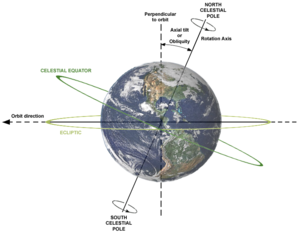What does celestial pole mean?
Definitions for celestial pole
ce·les·tial pole
This dictionary definitions page includes all the possible meanings, example usage and translations of the word celestial pole.
Princeton's WordNet
pole, celestial polenoun
one of two points of intersection of the Earth's axis and the celestial sphere
Wiktionary
celestial polenoun
An imaginary point situated where a planet's axis intersects the celestial sphere.
Wikipedia
Celestial pole
The north and south celestial poles are the two points in the sky where Earth's axis of rotation, indefinitely extended, intersects the celestial sphere. The north and south celestial poles appear permanently directly overhead to observers at Earth's North Pole and South Pole, respectively. As Earth spins on its axis, the two celestial poles remain fixed in the sky, and all other celestial points appear to rotate around them, completing one circuit per day (strictly, per sidereal day). The celestial poles are also the poles of the celestial equatorial coordinate system, meaning they have declinations of +90 degrees and −90 degrees (for the north and south celestial poles, respectively). Despite their apparently fixed positions, the celestial poles in the long term do not actually remain permanently fixed against the background of the stars. Because of a phenomenon known as the precession of the equinoxes, the poles trace out circles on the celestial sphere, with a period of about 25,700 years. The Earth's axis is also subject to other complex motions which cause the celestial poles to shift slightly over cycles of varying lengths (see nutation, polar motion and axial tilt). Finally, over very long periods the positions of the stars themselves change, because of the stars' proper motions. To take into account such movement, celestial pole definitions come with an epoch to specify the date of the rotation axis; J2000.0 is the current standard. An analogous concept applies to other planets: a planet's celestial poles are the points in the sky where the projection of the planet's axis of rotation intersects the celestial sphere. These points vary because different planets' axes are oriented differently (the apparent positions of the stars also change slightly because of parallax effects).
ChatGPT
celestial pole
A celestial pole is either of the two points where the imaginary line about which the Earth rotates, i.e., the Earth's axis, intersects the celestial sphere - an imaginary sphere enclosing the Earth, on which all celestial objects appear to lie. The two points are known as the north and south celestial poles. They are directly above the geographic North and South Poles of Earth respectively.
Wikidata
Celestial pole
The north and south celestial poles are the two imaginary points in the sky where the Earth's axis of rotation, indefinitely extended, intersects the imaginary rotating sphere of stars called the celestial sphere. The north and south celestial poles appear permanently directly overhead to an observer at the Earth's North Pole and South Pole respectively. As the Earth spins on its axis, the two celestial poles remain fixed in the sky, and all other points appear to rotate around them, completing one circuit per day. The celestial poles are also the poles of the celestial equatorial coordinate system, meaning they have declinations of +90 degrees and −90 degrees. The celestial poles do not remain permanently fixed against the background of the stars. Because of a phenomenon known as the precession of the equinoxes, the poles trace out circles on the celestial sphere, with a period of about 25,700 years. The Earth's axis is also subject to other complex motions which cause the celestial poles to shift slightly over cycles of varying lengths; see nutation, polar motion and axial tilt. Finally, over very long periods the positions of the stars themselves change, because of the stars' proper motions.
Matched Categories
Numerology
Chaldean Numerology
The numerical value of celestial pole in Chaldean Numerology is: 6
Pythagorean Numerology
The numerical value of celestial pole in Pythagorean Numerology is: 8
Translations for celestial pole
From our Multilingual Translation Dictionary
- வான துருவTamil
Get even more translations for celestial pole »
Translation
Find a translation for the celestial pole definition in other languages:
Select another language:
- - Select -
- 简体中文 (Chinese - Simplified)
- 繁體中文 (Chinese - Traditional)
- Español (Spanish)
- Esperanto (Esperanto)
- 日本語 (Japanese)
- Português (Portuguese)
- Deutsch (German)
- العربية (Arabic)
- Français (French)
- Русский (Russian)
- ಕನ್ನಡ (Kannada)
- 한국어 (Korean)
- עברית (Hebrew)
- Gaeilge (Irish)
- Українська (Ukrainian)
- اردو (Urdu)
- Magyar (Hungarian)
- मानक हिन्दी (Hindi)
- Indonesia (Indonesian)
- Italiano (Italian)
- தமிழ் (Tamil)
- Türkçe (Turkish)
- తెలుగు (Telugu)
- ภาษาไทย (Thai)
- Tiếng Việt (Vietnamese)
- Čeština (Czech)
- Polski (Polish)
- Bahasa Indonesia (Indonesian)
- Românește (Romanian)
- Nederlands (Dutch)
- Ελληνικά (Greek)
- Latinum (Latin)
- Svenska (Swedish)
- Dansk (Danish)
- Suomi (Finnish)
- فارسی (Persian)
- ייִדיש (Yiddish)
- հայերեն (Armenian)
- Norsk (Norwegian)
- English (English)
Word of the Day
Would you like us to send you a FREE new word definition delivered to your inbox daily?
Citation
Use the citation below to add this definition to your bibliography:
Style:MLAChicagoAPA
"celestial pole." Definitions.net. STANDS4 LLC, 2025. Web. 6 Mar. 2025. <https://www.definitions.net/definition/celestial+pole>.







Discuss these celestial pole definitions with the community:
Report Comment
We're doing our best to make sure our content is useful, accurate and safe.
If by any chance you spot an inappropriate comment while navigating through our website please use this form to let us know, and we'll take care of it shortly.
Attachment
You need to be logged in to favorite.
Log In